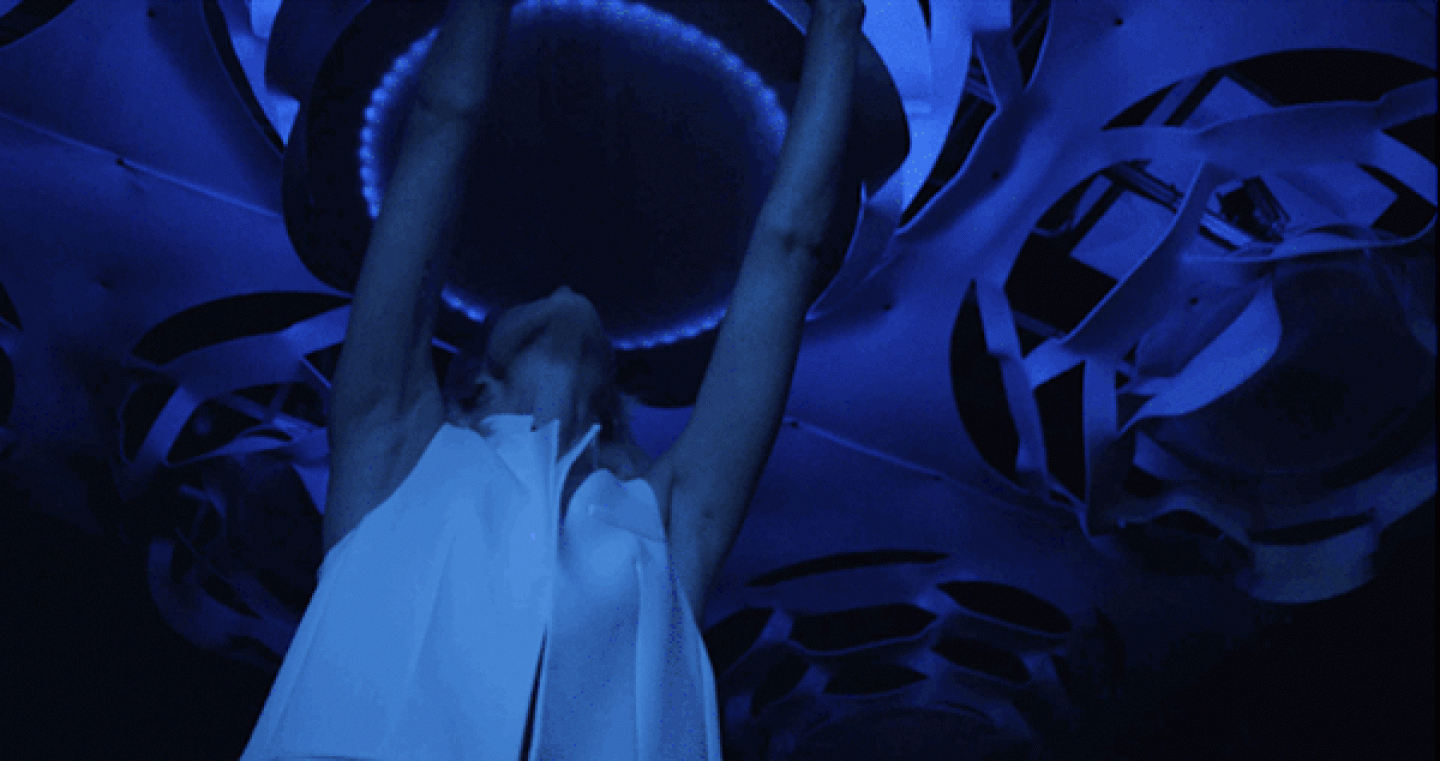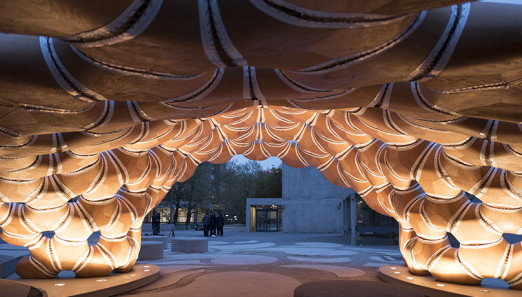Behnaz Farahi’s profile at the University of Southern California research organisation begins with the simple proposition that she is “an architect”. Her professional and creative journey is also an exploration of what that means in the 21st Century. Farahi completed Undergraduate and two Masters Degrees at Shahid Beheshti University in her native Iran and at the University of Southern California, and is currently pursuing a PhD in iMAP (Interdivisional Media Arts + Practice) at the School of Cinematic Arts at the University of Southern California. She was an Artist in Residency at Autodesk, Pier 9.
Her work explores the intersection between biology, interaction and materials, testing the boundaries of what it is to be a building, a human, and the increasingly complex notion of what the built environment is.
While many visions of our increasingly interactive environments and cities feel linear and static rather than like generative feedback systems, Farahi’s work explores genuinely adaptive environments.
Her recent project, Aurora, done in conjunction with workspace company SteelCase Inc, asks the questions “Will architectural spaces be able to incorporate interactivity, unpredictability and motion in order to serve as a kinetic interface, communicating stories of the activities of its inhabitants? And will the dynamic soft architecture of future be able to convey information about the activities of users within the space, just as by looking at the surface of the ocean, one can read the wind direction?”
Farahi speaks to us below about her experimental projects and how they can play out in the built environment.
Your background education is in architecture and your research is seeking to “enhance the relationship between human beings and the built environment by implementing design/motion principles inspired by natural systems.” Could you tell us a little about that journey?
Behnaz Farahi: The history of architecture can be read as a history of the relationship of human beings to their built environment. Attempts to relate the human bodily proportions to those of built environment – from Vitruvius through to Le Corbusier and beyond - are part of this history. However, in our contemporary age, another set of possibilities has emerged through the developments of interactive systems that allow users to relate to their environment in a radically new way.
Recent advances in ubiquitous computing allow designers to design spaces that can adapt to their users and reconfigure their physical form, so as to create a new empathetic relationship between the animate bodies of the users and the otherwise inanimate material of the environment. I am interested to see how bio-inspired design from “morphology” and “behaviour” of natural systems can inform a new kind of architecture augmented with artificial intelligence that enables it to respond.
Were there any particular projects or experiences during your work in architectural practices that inform your current work?
Behnaz Farahi: I worked for few months at SDA (Synthesis of Architecture and Design) in Los Angeles which focuses on a variety of projects exploring the relationship between form and performance. I think that it was important for me to be exposed to the exploration of material behaviour and material computation aiming to blur the boundaries between digital and physical design, and this certainly informed and inspired my own practice.
From Hylomorphic Canopy, through Living Breathing Wall to Aurora your work explores adaptive environments and biology. Could you talk us through the evolution of your thinking?
Behnaz Farahi: Holomorphic Canopy is a speculative design for a structure capable of crawling in a city street based on human movement and their density, but that remains in a digital realm.
All later projects are an attempt to be involved with the physical world and see material limitations as a design challenge to explore interactive dynamic design.
(From Behnaz Fahari's wesbite, "This project [Hylopmorphic Canopy] is a new kind of canopy that’s capable of interacting with human movement and density in Los Angeles. Street fairs, block parties, art walks are potential settings. How can architecture respond to these kinds of cultural activities within the city? Can we rethink how people interact with the environment and vice versa?")
In my subsequent projects – from Alloplastic Architecture that tracks and responds to the movement of a dancer to Breathing Wall...
...which moves based on hand gesture, to Living Wall which moves based on spoken words, to Aurora which is a ceiling which detects and track people movement and responds accordingly – there is an attempt to rethink and explore new ways that our bodies relate to architectural spaces.
Each project explores three interconnected realms of “geometry”, “behaviour” and “interaction”: geometry as a way to control material behavior; behaviour as a means of actuation; and lastly interaction as an interactive system of control.
Who are the architects, designers, artists, thinkers that inspire your work? Who are the antecedents?
Behnaz Farahi: My work inspired from various disciplines of Architecture, Neuroscience, Robotics and Cognitive Science.
· Architecture: Frei Otto, Antonio Gaudi
· Interactive system/ cybernetics: Norbert Wiener, Gordon Pask, Hiroshii Ishii
· Neuroscience: Antonio Damasio
· Robotics: Rodney Brooks, Skylar Tibbits and various researchers on Soft Robotics
· Cognitive Science/ Philosophy: Andy Clarke, Manuel DeLanda, Katherine Hayles
How did your collaboration with MEML Lab and Steel Case inc for Aurora come about? Could you tell us a little about the materials and construction?
Behnaz Farahi: I developed Aurora (interactive kinetic ceiling installation), as part of a research collaboration between USC Mobile and Environmental Media Lab (MEML) and SteelCase Inc. on the future of the built environment – particularly working spaces. This research project involves many different design/research aspects, from speculative storytelling to the design of actual prototypes including probes and furniture, to the use of Virtual and Augmented Reality for exploring possible narratives, teleconferencing, as well as atmospheric sound design for our working spaces.
Aurora is an attempt to explore how the form of the environment can physically be dynamic and develop a reciprocal relationship between animated body of the user and otherwise inanimate surrounding environment. Therefore, the main intention was to design a space that could detect users and their movements and reconfigure its shape accordingly.
Measuring 15’ by 15’ the project is installed on a pre-existing ceiling grid, and is composed of five active/dynamic and four passive/static modules covered by mesostructural industrial felt. This project includes five floating motion disks, which not only move in Z direction but also have the ability to rotate in various other directions in 3D Vector space. The skin is made of industrial felt cut from a single 2D sheet in order to provide enough flexibility for transformations of each disk. The ‘cut’ of the industrial felt combined with the ‘drape’ of the material therefore offer the material different qualities depending on direction of the movement.
How do you see these kinds of interactive spaces being played out in the built environment?
Behnaz Farahi: Historically, interactive architecture has responded to pragmatic reasons such as the changing needs of users, space efficiency and so on. However, nowadays, the motivation in interactive dynamic spaces is to explore the potential implementation of new technologies to human patterns of interaction. In other words, we can rethink the relationship of the human body to architectural spaces by applying new interactive technologies. Therefore, by advances in sensory environments, “embodied interaction” can be seen as an alternative way of moving beyond conventional press-button building control systems. In this sense, I am dealing with the motivation and – more importantly – different techniques of using interactive systems through a series of experimental design projects. These new possibilities are changing the way that we interact with the world around us by influencing our embodiment, perception, ways of communicating, and awareness.
See more of Behnaz Farahi's work here
Behnaz Farahi is speaking in London at The Bartlett on May 17. For further information click here.
John O'Reilly



